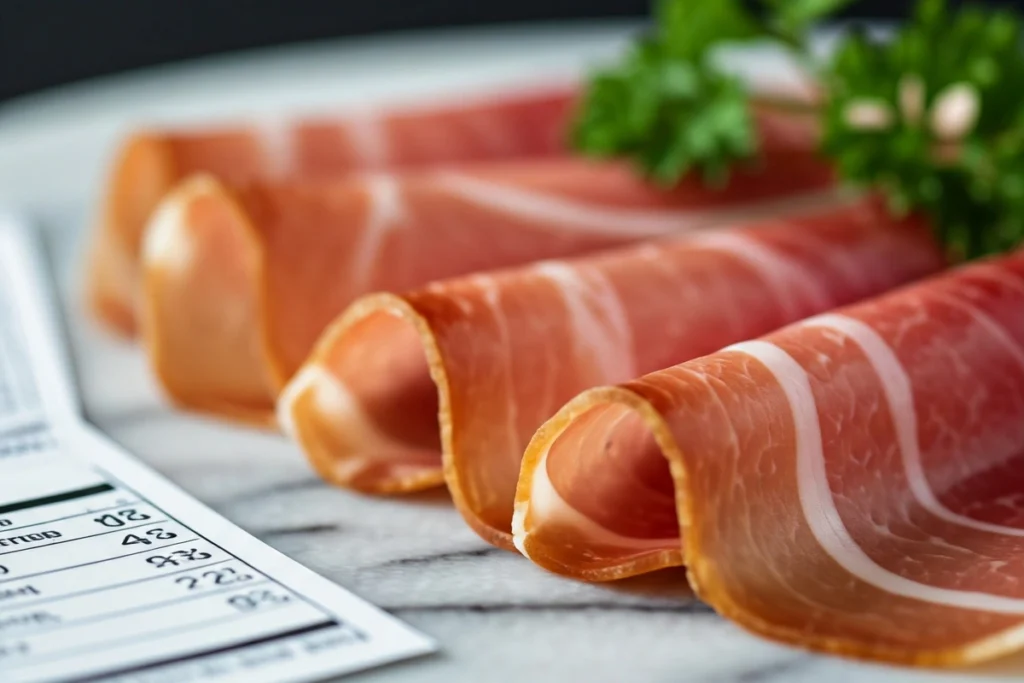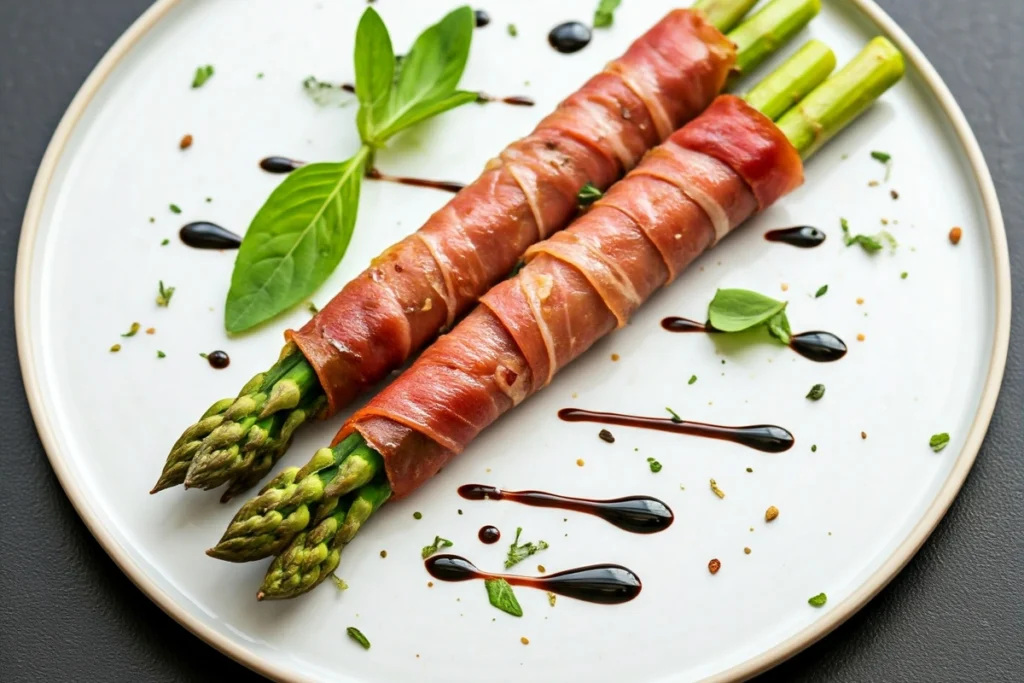Prosciutto, a delicacy beloved for its delicate texture and savory taste, often graces charcuterie boards, gourmet recipes, and traditional Mediterranean dishes. But is prosciutto healthy? This article dives deep into the nutritional profile, health benefits, and potential concerns associated with this cured meat. Whether you’re curious about how it fits into popular diets or looking for tips to enjoy it more healthily, we’ve got you covered.
What Is Prosciutto?
What Defines Prosciutto?
Prosciutto is a traditional Italian cured meat made from pork legs, known for its paper-thin slices and melt-in-your-mouth texture. The word “prosciutto” comes from the Italian term prosciugare, meaning “to dry thoroughly.” This reflects its meticulous preparation process, which involves salting and aging the meat to perfection.
Unlike other processed meats, prosciutto crudo (uncooked) is air-dried, while prosciutto cotto (cooked) undergoes a different preparation. Its unique taste—salty, slightly sweet, and rich—sets it apart as a gourmet food staple.
Traditional Methods of Curing and Preparation
The making of prosciutto is an age-old craft, steeped in Italian heritage. Pork legs are carefully cleaned, salted, and left to age in controlled environments for months, sometimes even years. This slow curing process not only intensifies its flavor but also preserves the meat naturally without the need for heavy processing.
Varieties of Prosciutto: Crudo vs. Cotto
Prosciutto comes in two main forms:
- Prosciutto Crudo: This uncooked version is dry-cured and aged, giving it a robust, savory flavor. Common types include Prosciutto di Parma and Prosciutto di San Daniele.
- Prosciutto Cotto: A milder, cooked version, prosciutto cotto is steamed and retains a softer texture, making it a versatile addition to sandwiches and salads.
Both types offer distinct culinary experiences, but their nutritional values differ slightly due to variations in preparation.
By understanding what prosciutto is and how it’s made, you can better appreciate its role in the culinary world. But how does it fare nutritionally? Let’s explore in the next section!
Nutritional Profile of Prosciutto
Macronutrients in Prosciutto
Prosciutto is a nutrient-dense cured meat that packs a lot of energy into small servings. A 1-ounce slice of prosciutto provides approximately 70 calories, with about 3.5 grams of fat and 8 grams of protein. It’s naturally low in carbohydrates, making it a perfect fit for low-carb or keto diets. The high protein content helps support muscle repair and growth, while the fat content provides a source of sustained energy.
Micronutrients: Sodium, Potassium, and Iron
Prosciutto contains essential micronutrients like iron, which is crucial for oxygen transport in the body, and potassium, which aids in maintaining electrolyte balance. However, it’s also high in sodium, with a single slice containing over 600 milligrams. While sodium helps regulate fluid balance and nerve function, excessive intake can raise blood pressure, so moderation is key.
Caloric Content: Is Prosciutto High in Calories?
Given its rich flavor and nutrient density, prosciutto isn’t particularly high in calories, but portion control matters. Eating several slices can quickly add up in terms of caloric intake. Compared to other processed meats like bacon or salami, prosciutto often provides a more balanced nutritional profile.
To learn more about complementary foods that pair well with prosciutto, explore this guide on creative ways to use gourmet ingredients.
Health Benefits of Prosciutto
Rich in Protein: Muscle Building and Repair
Prosciutto’s high protein content makes it an excellent option for supporting muscle health. Protein is essential for tissue repair, immune function, and the production of enzymes and hormones. Whether included in breakfast or as a snack, it can provide a quick protein boost.
Source of Essential Vitamins and Minerals
Beyond protein, prosciutto is a valuable source of B-vitamins, including niacin and riboflavin, which are essential for energy production. The presence of minerals like zinc and selenium further supports immune health and antioxidant protection. Incorporating prosciutto into your diet can enhance your intake of these important nutrients.
Low-Carb and Keto-Friendly Snack Option
With zero carbs per serving, prosciutto aligns perfectly with ketogenic and low-carb lifestyles. It’s versatile enough to be paired with nutrient-dense foods like avocados, leafy greens, or fresh fruits like melon. The combination not only balances flavors but also boosts the overall nutrient profile of a meal.

Adding prosciutto to recipes such as salads, wraps, or gourmet pizzas is an easy way to enjoy its benefits. Check out creative pizza topping ideas here to elevate your dishes while keeping them nutritious.
Potential Health Concerns
High Sodium Content: Risks of Excess Salt Intake
One of the primary health concerns associated with prosciutto is its high sodium content. While salt is crucial for preserving the meat and enhancing its flavor, consuming too much sodium can increase the risk of high blood pressure, heart disease, and stroke. A single slice of prosciutto contains more than 600 milligrams of sodium, which is roughly 25% of the recommended daily limit. If you’re asking, “Is prosciutto healthy for everyone?”, the answer often depends on how much you eat and your overall dietary sodium intake.
Processed Meats and Nitrates: What You Should Know
Prosciutto falls under the category of processed meats, which often contain nitrates or nitrites—compounds used to prevent spoilage and enhance flavor. While traditionally cured prosciutto may rely on natural salts, some varieties include added nitrates, which have been linked to an increased risk of certain cancers when consumed excessively. Choosing nitrate-free options or consuming prosciutto in moderation can help mitigate these risks.
Allergies and Dietary Restrictions
For individuals with specific dietary needs, it’s important to note that prosciutto is derived from pork and may not align with kosher, halal, or vegetarian diets. Additionally, those with salt sensitivities or conditions like kidney disease should consume prosciutto sparingly. Always check the labels for additional ingredients, especially if you’re prone to food allergies.
For a deeper understanding of pairing ingredients with prosciutto, check out this guide on perfect ingredient combinations.
Prosciutto in Popular Diets
Prosciutto in Mediterranean Diets
The Mediterranean diet emphasizes whole, minimally processed foods like fruits, vegetables, nuts, and lean proteins. Is prosciutto healthy within this context? Absolutely—when consumed in moderation. It’s often paired with fresh produce such as melon, figs, or arugula, offering a delightful balance of flavors while staying true to the diet’s principles.
Is Prosciutto Paleo-Compatible?
While the paleo diet excludes most processed foods, traditionally made prosciutto, free of artificial additives, can be an exception. Its high protein content aligns well with the paleo focus on clean, nutrient-dense foods. However, it’s important to choose varieties with no added nitrates or sugars.
Incorporating Prosciutto into Low-Carb Diets
For those following low-carb or ketogenic diets, prosciutto is an excellent choice. Its near-zero carb content and high fat-to-protein ratio make it ideal for maintaining ketosis. Pair it with avocado slices or wrap it around grilled asparagus for a satisfying, healthy snack.
If you enjoy experimenting with versatile ingredients, explore creative ways to use gourmet foods like prosciutto.
How to Enjoy Prosciutto in a Healthy Way
Serving Suggestions: Pairing with Fruits and Vegetables
One of the best ways to enjoy prosciutto is by pairing it with fresh, nutrient-rich fruits and vegetables. For instance, wrapping prosciutto around melon slices creates a perfect balance of sweet and savory. You can also try combining it with leafy greens like arugula in salads or serving it alongside roasted asparagus for an elegant appetizer. These pairings not only enhance flavor but also add fiber, vitamins, and minerals to your meal, making the answer to “Is prosciutto healthy?” more nuanced when eaten this way.
Moderation is Key: Portion Control Tips
While prosciutto is delicious, moderation is essential due to its high sodium content. A serving of about 1–2 ounces is generally enough to enjoy the flavor without overindulging. Use it as a garnish rather than the main ingredient—thin slices can stretch far on pizzas, in wraps, or as toppings for scrambled eggs. By focusing on portion control, you can enjoy its unique taste without compromising your health goals.
Healthy Recipes Featuring Prosciutto
There are endless ways to incorporate prosciutto into your recipes while keeping them nutritious. Try making prosciutto-wrapped chicken breasts, baked until golden and crispy. Or, add prosciutto strips to a veggie-filled frittata for a protein-packed breakfast. These recipes let you savor the rich flavors of prosciutto while maintaining a balanced diet.

Comparing Prosciutto to Other Cured Meats
Prosciutto vs. Bacon: Which is Healthier?
When comparing prosciutto to bacon, prosciutto comes out ahead in terms of nutrition. While both are cured meats, bacon is often higher in fat and calories due to its thicker cut and frying preparation. Prosciutto, on the other hand, is air-dried and usually contains fewer additives. If you’re wondering, “Is prosciutto healthy compared to bacon?”, it’s often the better choice, especially in moderation.
Prosciutto vs Salami : Nutritional Differences
Salami, another popular cured meat, differs significantly from prosciutto in both flavor and nutritional content. Salami is denser, contains higher amounts of fat, and often includes spices and preservatives. Prosciutto’s delicate, thin slices and simpler curing process make it a lighter, less processed alternative. If you’re aiming for a healthier diet, prosciutto’s lower fat content is a clear advantage.
Jamón Serrano vs. Prosciutto: Regional Varieties
Jamón Serrano, a Spanish delicacy, shares many similarities with Italian prosciutto. Both are dry-cured hams, but the curing times and flavors vary slightly. Jamón Serrano tends to have a firmer texture and saltier taste, while prosciutto is softer and sweeter. Nutritionally, they are comparable, but prosciutto’s delicate preparation may make it a more appealing choice for some.
For those curious about expanding their culinary horizons, experimenting with different cured meats can be rewarding. Each offers a unique taste profile that complements various dishes, but if you’re looking for a lighter, nutrient-rich option, prosciutto is often the winner.
The Science Behind Prosciutto and Longevity
Curing Process and Its Role in Preserving Nutrients
The traditional curing process of prosciutto plays a significant role in its nutritional profile. By air-drying the pork over months or even years, prosciutto retains its essential nutrients, such as protein and minerals, while minimizing the need for heavy preservatives. This natural approach to preservation contrasts with more industrialized methods, making many people wonder, “Is prosciutto healthy because it’s less processed?” The answer lies in its artisanal preparation, which emphasizes quality over additives.
Studies on Cured Meats and Lifespan
While some studies link high consumption of processed meats to health concerns, the occasional inclusion of high-quality options like prosciutto may offer benefits when paired with a balanced diet. Prosciutto’s high protein and low carbohydrate content make it compatible with diets known to promote longevity, such as the Mediterranean diet. However, moderation is key. Excessive sodium intake, common with cured meats, can offset any potential health benefits.
For those looking to balance taste and health, combining prosciutto with nutrient-rich foods like fresh vegetables or whole grains is an excellent strategy. This approach not only enhances meals but also ensures a variety of nutrients.
FAQs About Prosciutto and Health
Is Prosciutto Good for Weight Loss?
Prosciutto can be part of a weight-loss plan when consumed in moderation. Its high protein content helps keep you full longer, reducing the urge to snack between meals. Additionally, its low carbohydrate count makes it a popular choice for those on keto or low-carb diets. But beware—its high sodium content means portion control is essential.
Can Prosciutto Be Part of a Heart-Healthy Diet?
If you’re asking, “Is prosciutto healthy for heart health?”, the answer depends on how it’s consumed. While prosciutto is rich in protein and low in carbs, its high sodium levels can pose risks for individuals with hypertension or heart disease. Pairing prosciutto with potassium-rich foods like bananas or spinach can help counterbalance sodium levels and support cardiovascular health.
Is Prosciutto Safe During Pregnancy?
For expectant mothers, the safety of prosciutto depends on how it’s prepared. Traditionally cured prosciutto that hasn’t been cooked may pose a risk of bacterial contamination, such as listeria. To ensure safety, pregnant women should stick to fully cooked versions of prosciutto or consult their healthcare provider.
For more tips on pairing prosciutto with healthy ingredients, check out this helpful guide.
Conclusion: Is Prosciutto Healthy?
The question “Is prosciutto healthy?” doesn’t have a simple yes or no answer—it largely depends on how it’s consumed and integrated into your diet. Prosciutto is a nutrient-rich, protein-packed option with low carbohydrates, making it ideal for various dietary plans, such as keto, Mediterranean, or paleo. Its artisanal preparation and delicate flavor profile add sophistication to any dish.
However, its high sodium content and classification as a processed meat mean it should be enjoyed in moderation. Pairing prosciutto with fresh, nutrient-dense foods like fruits, vegetables, and whole grains can help offset potential drawbacks while maximizing its benefits.
Ultimately, prosciutto can be a flavorful and health-conscious choice when balanced with a well-rounded diet and mindful portion sizes. By savoring this Italian delicacy responsibly, you can enjoy its unique taste without compromising your health.

